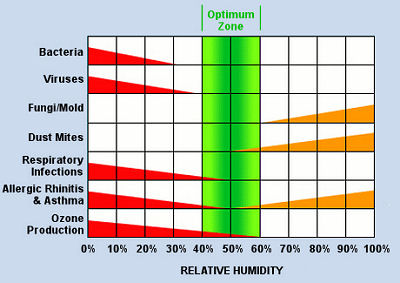The 4 Factors of Comfort

My grandmother was ‘cold-natured,’ which meant she was more often too cold than too hot. My grandfather could sweat just by thinking about going outside on a summer day in Louisiana (where summer lasts for 5 months). Yet they lived together comfortably for over half a century. How is that possible?
The answer is that for most people, most of the time, the range of conditions that we’re comfortable in is pretty narrow. If the temperature’s between 70 and 80 degrees Fahrenheit and the relative humidity (RH) between 30% and 70%, we’re more or less comfortable.
Of course, the closer the humidity is to 70%, the lower the temperature needs to be for us to be comfortable. At 70% RH, most of us will want the temperature to be 75 degrees or lower. By keeping the RH at 50% or below, we can tolerate a slightly higher temperature.
(These two factors, temperature and humidity, are intertwined in the psychrometric chart. Developed by Willis Carrier, the inventor of modern air conditioning, the psychrometric chart is fundamental to building science – and perhaps the topic of another article.)
So, temperature and humidity are two important factors of comfort. Let’s look at all four factors of comfort now:
- Temperature. How hot or cold is it? Humans like to be in the range of 70 to 80 degrees, more or less. This is the most obvious of the 4 factors of comfort and gets the most attention.
- Humidity. How much moisture is in the air? Forty to sixty percent relative humidity is the ideal range. In addition to decreasing comfort, a relative humidity that’s too low or too high increases the likelihood of things like bacteria, mold, dust mites. (See the diagram below.)
- Air Movement. Is the air moving across your skin? In the summer, one way that our bodies keep cool is by the evaporation of sweat. A nice breeze or a ceiling fan can keep us comfortable even when the the temperature and humidity are at or above the narrow range we find most comfortable. In the winter, that same air movement will make us uncomfortable.
- Mean Radiant Temperature. How hot or cold are the surfaces around you? Of the four factors of comfort, this one’s the least recognized or understood, but let me give you a couple of examples. If you’ve ever been in an old uninsulated house with single pane windows on a cold night, you’ve probably experienced discomfort due to a low mean radiant temperature. The cold inner wall surfaces and glass suck heat out of your body because you’re radiating heat to them but they’re not radiating much back. Another mean radiant
 temperature problem occurs in bonus rooms, where you have walls with hot attic on the other side. Most of the time those attic kneewalls are poorly insulated and thus get very hot. Even if the air temperature in that room is 70 degrees, you may be uncomfortable because the walls keep blasting you with heat. The photo here shows an infrared image of a hot attic kneewall, and you can see from the wide range of colors that the wall is very hot in most places but very cold by the air conditioning vent.
temperature problem occurs in bonus rooms, where you have walls with hot attic on the other side. Most of the time those attic kneewalls are poorly insulated and thus get very hot. Even if the air temperature in that room is 70 degrees, you may be uncomfortable because the walls keep blasting you with heat. The photo here shows an infrared image of a hot attic kneewall, and you can see from the wide range of colors that the wall is very hot in most places but very cold by the air conditioning vent.
The two things that most affect our comfort in buildings are the building envelope (insulation and air barrier) and the heating and cooling system. Good insulation, properly installed and in contact with the air barrier, and a tight house go a long way to helping. Good HVAC design takes us the rest of the way. When it all works harmoniously together, we’re comfortable, and the house is also efficient, durable, and healthful.
This Post Has One Comment
Comments are closed.

I’d also posit that another
I’d also posit that another factor of comfort is the attributes of the HVAC functions:
* Quality of the air (filtered or smelly, etc.)
* Sound (how much does it interfere with our activities?)
* Air movement and temperature while running: It may be 76 at the thermostat, but 65 degree air blowing on the body may make one chilly.